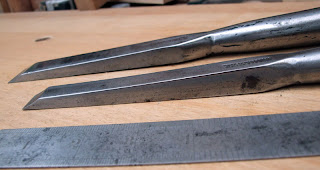So confined to barracks as I am, I need cheering up. Non-woodworking comforts in these times of feeling sorry for oneself traditionally veer towards re-reading Pride and Prejudice and having an inexplicable desire to eat Marmite and honey on toast.
Yes, together. No, it's not weird. People eat sweet and sour combos all the time.
Okay, it's a bit weird. Moving on then...
What woodworking thing will cheer me? Ooo, I dunno. It's a truth universally acknowledged that I do like a nice chisel or two though... (Okay, who saw that coming? Predictable, ain't I?)
Cast you mind, or even your browser, back to the acquisition of the contents of a tool chest that proved to be that of a coachbuilder. More specifically, the chisels of same. Not being a big fan of picking up a chisel and coming away with an orange palm from all the rust thereon, I'm gradually getting round to cleaning them up. In this case, a pair of socketed beauties by Thomas Ibbotson & Co.
That's no six inch rule there either; them's a big ol' pair of chisellin' devices. 1in. and 5/8in. 'Cos I was curious I threw them on the scales and they came in at 1lb 3oz and 15oz respectively, but they don't feel at all unwieldy. Just really nice chisels.
Now inexplicably I don't have an Ibbotson catalogue about my person (cries of "Shame!" and that's just from me) but I do have a 1934 Marples one handy, and also because Salaman's Dictionary copped out and lumped all the firmers together with gay abandon, I referred to Bill and his boys compendium of toolish goodness.
Now isn't it interesting that the ones like these Ibbotsons, with no overly mannered shoulder, are just "Socket chisels", while the ones with the obvious shoulders get the "Firmer" moniker. I wonder why. I included the others just for kicks and giggles, and who doesn't like playing the Time Machine Game and pricing themselves up a set of bevel-edge cabinet chisels?
Depressingly, I know damn well that certain folks will take this and declare it supports their assertion that no-one bothered with flat backs until the modern era. I'd argue that it merely supports the evidence that the canny woodworker puts only the effort into a tool that's required for the tool to do the job. Like not sharpening a rough jack plane iron to a superfine edge; there's just no point. I don't suppose these two chisels were doing much paring to nths of a gnat's pay slip.
Also, we should probably bear in mind that in the same kit of tools was this error of chisel-using judgement, so, y'know, maybe this guy, or possibly gal, is not the ideal example of what to do.
It also struck me as interesting that there was a noticeable hollow grind and at a not especially sturdy 25° too. Heavy duty chisels though these clearly are, no concerns about the edge not holding up.
And finally, because not everyone will have the opportunity and it's really annoying when you read about this stuff but can't see it, the very obvious lamination of the hard steel to the blade.
So a nice pair of chisels that leave me with all kinds of decisions over how best to get them working. Add in some rusting on the backs, and I'm looking at quite a bit of effort needed there. i.e. Those backs aren't likely to be getting much flatter, unless I want to kiss the steel goodbye. Heigh ho. On the up side I already have a similar Marples in a 3/8in size (if I recall correctly), so it'll be worth doing to get something of a "set".
You know how people advise you to have a set of "beater" chisels that you can safely whale on without worry? Yeah, I reckon they might fit the bill just dandy.






Ah Alf,
ReplyDeleteYou have caught on camera the smallish sliver of tool steel (which was expensive to make) from which these chisels derived their edge retention. Joined to the rather larger bit of wrought iron (which was not so expensive to make). And isn't it a bit of a nuisance that the tool steel bit is that much more attractive to the all too common pitting corrosion bug! And the hard steel is so-o-o much harder to remove said pitting from! Thats why some of my flea market chisel finds still languish, partially cleaned, after sheets of wet and dry paper have been expended in an effort to remove the pitting.
You are dead right about the chisel backs not being as straight as the precision ground stuff being produced today - the only straightening treatment those chisels got was at the blacksmiths forge. The bevel shape probably did not concern the craftsman as much as we think nowadays - but then he had to earn a living from it! Cheers, Mark